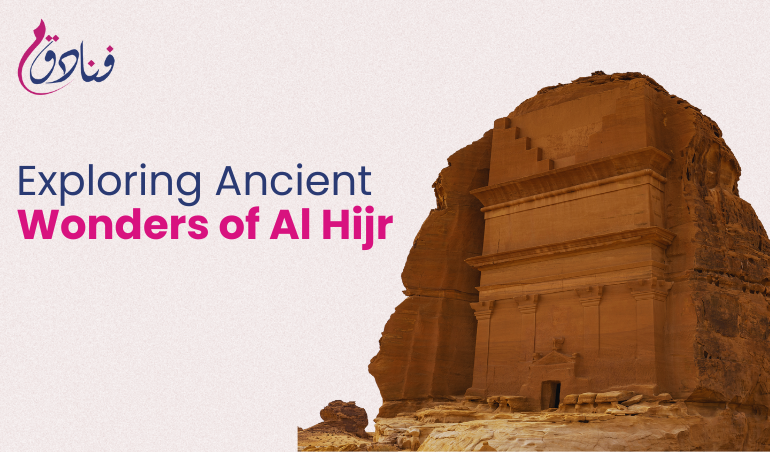Exploring Hegira Madain Saleh: A Glimpse Into The Enigmatic Al Hijr Archaeological Site
By Funadiq Team
Hidden within the vast Arabian desert stands a breathtaking testament to ancient civilization. Al Hijr archaeological site, also known as Hegira Madain Saleh, is a UNESCO World Heritage Site that will transport you back in time to the Nabataean civilization in the south of what is now Jordan. This awe-inspiring architectural marvel is situated at the intersection of ancient trade routes in the Arabian Peninsula. Referred to as "The Capital of Monuments," the site is adorned with magnificent facades and ancient inscriptions and boasts over 100 tombs and water wells that showcase the incredible hydraulic and architectural prowess of the Nabataeans. It's a place where history comes alive and a must-see for anyone fascinated by ancient wonders.
Hegra History
Madain Saleh, also known as Al Hijr, is a hidden gem nestled in the Al-Ula region of northwestern Saudi Arabia. This extraordinary site is renowned for its remarkably well-preserved tombs and rock-cut structures, dating back to the first century BCE. The breathtaking natural scenery and stunning vistas captivated the Nabataeans, leading them to settle in this awe-inspiring location that bears a striking resemblance to their original homeland, Petra, in northern Jordan, with its imposing sandstone cliffs.
Hegra Madain Saleh was once a bustling hub where the Nabataeans built their homes, tended to their flocks of sheep and camels, and pioneered oasis agriculture. Tracing the footsteps of their predecessors, they carved out a unique way of life in this arid landscape. The remnants of this ancient civilization offer a tantalizing glimpse into the Nabataean lifestyle, revealing their religious practices, austere laws, and mastery of desert survival.
Legend has it that the Nabataeans held sway over the spice trade in the region, transporting coveted spices from the southern reaches of Saudi Arabia to the north, where they were eagerly sought after by Roman Egyptians, Greeks, Phoenicians, and other Mediterranean civilizations.
While the tombs are a prominent feature of this remarkable site, the ruins of the Hegra town lie a bit further afield, adding to the air of mystery that still shrouds much of this ancient marvel. With many parts of the site yet to be excavated, the unexplored areas resemble sun-dried mud bricks, offering a tantalizing prospect for future discovery. The inscriptions found on the tombs serve as a captivating link to the past, providing valuable insights for historians and archaeologists.
The Story of Al Hijr
According to Islamic history, Al-Hijr was once home to the ancient Thamud tribe. These people built magnificent homes and palaces in the mountains and plains. The story takes a thrilling turn when the tribe begins worshipping idols and committing acts of oppression. In response, the noble Saleh (AS) urges them to repent and offers them a chance for forgiveness by presenting a pregnant camel and asking the tribe to care for it. Sadly, only a few heed Saleh's words, and the non-believers end up killing the camel. Saleh (AS) warns the tribe that they have three days before facing punishment. Fleeing the city with his followers, Saleh (AS) leaves the non-believers to face the wrath of Allah. They meet a tragic fate as they are buried under their own homes during a powerful earthquake and lightning event. However, many researchers argue that the tribe existed even before 715 BCE, and some accounts suggest that Thamud was the name of the region rather than the tribe.
Structures to See Inside Madain Saleh
The tombs of Hegra, which are part of the Al Hijr Archaeological Site, are breathtaking. They are among the most remarkable sites in Saleh, showcasing incredible ancient carvings and intricate details. Like Petra, these tombs feature beautiful façades with magnificent carvings and skillful craftsmanship. The opulent entrances to the tombs are truly awe-inspiring, and the walls inside are adorned with carvings where the deceased were laid to rest. This place truly deserves attention and admiration for its historical and architectural significance.
The Nabatean inscriptions found in Madain Saleh indicate the presence of tricliniums, which were spaces dedicated to rituals and banquets. At least six tricliniums have been discovered in the area.
Qasr al Bint, also known as the 'Palace of the Daughter of Madain,' is the largest tomb in Hegra, standing at a height of 16 meters. The tomb was sculpted by Hoor ibn Ahi for Hani ibn Tafsy, who, along with his family, lived there during the reign of the Nabataean King, Aretas IV, in 31 CE.
Qasr al-Farid is absolutely mesmerizing as it stands alone, carved entirely from a single stone. According to ancient records, these incredible tombs were carved from top to bottom.
Inside, you'll find fascinating carvings of winged lions, symbolizing the fascinating exchange between the Nabataean and Ptolemaic kingdoms.
The Jebel Ithlib is a large rock formation located in the northern part of the site. In the middle area, there is a natural cleft known as the Siq, which is 40 meters high and resembles the corridor at Petra. Adjacent to the entrance of the Siq is a square-shaped chamber with three stone benches where individuals would gather for sacred feasts. Following the Siq, there is a natural alcove called the Jebel Ithlib sanctuary. This area features a canal that directs water into a cistern and is believed to be a sacred site where ancient people worshipped Dushara, the Lord of the Mountain and a Nabataean deity.
Guided Tours and Travel Packages
It is highly recommended that you join a guided tour to fully appreciate the historical and cultural significance of Madain Saleh. Knowledgeable guides provide valuable insights and context, bringing the ancient ruins to life. Umrah Companions offers affordable travel packages that include expert-guided tours, ensuring a rich and informative experience.
Closing Thoughts
Exploring Hegira Madain Saleh feels like embarking on a journey through time and unravelling the mysteries of a long-lost civilization that once flourished in the heart of the Arabian desert. From the magnificent tombs of Qasr Al Farid to the intricate petroglyphs and sophisticated hydraulic systems, every facet of Madain Saleh narrates a tale of innovation, endurance, and artistic brilliance.
For travellers preparing for their adventure, Funadiq offers budget-friendly travel packages that guarantee a seamless and enriching experience. These comprehensive packages encompass all essential arrangements, including transportation, accommodations, and guided tours, allowing visitors to fully immerse themselves in the marvels of Madain Saleh and the cultural allure of Al-Ula.




0 Comments